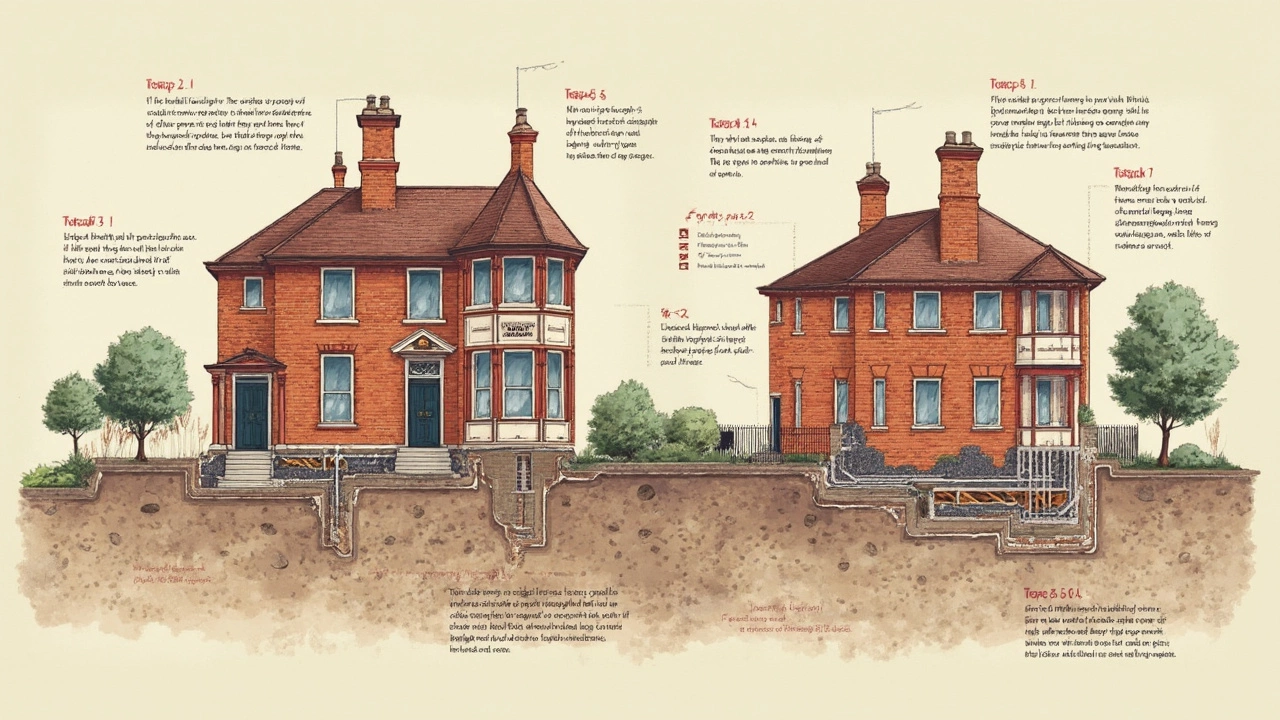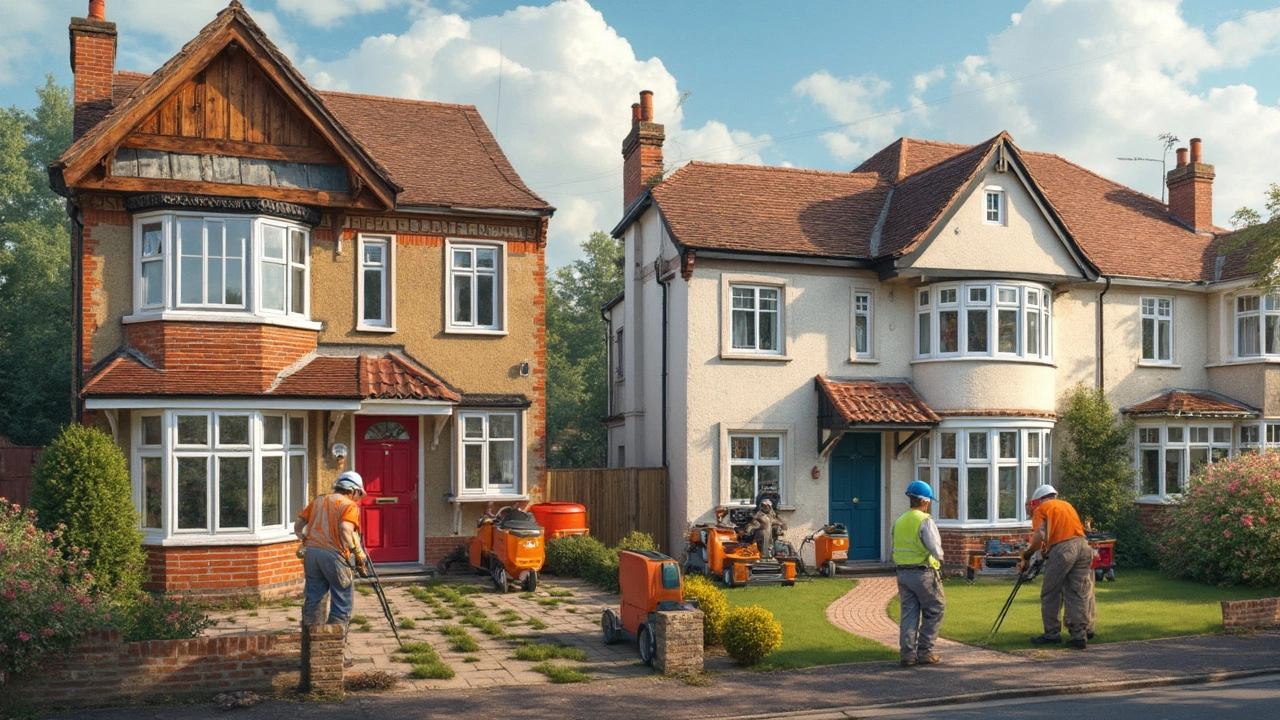Foundation cracks might not seem like a big deal at first, but leave them unchecked, and they can lead to some serious problems. So, do you fix them from the inside or outside? Well, there's no one-size-fits-all answer, but let's dive into what you need to know.
First off, understanding why these cracks happen can help you decide on the best course of action. Sometimes, it's just the house settling. Other times, it's pesky water or even our good friend, tree roots, causing the ruckus. Figuring out the root cause is half the battle.
Now, let's talk strategy. Fixing cracks from the inside can be quicker and easier, especially if you're dealing with minor problems or don't want to dig up your yard. But here's the catch: it's like putting a band-aid on a bigger issue if the outside forces aren't managed. On the flip side, tackling it from the outside means getting to the root problem, but it might require more time and money.
Both methods have their perks and downfalls, and in some cases, doing a bit of both might be the best option. So, grab your toolbelt, or maybe your phone to call a pro, and let’s get those cracks sorted!
- Understanding Foundation Cracks
- Inside Repairs: Pros and Cons
- Outside Repairs: Pros and Cons
- When to Call a Professional
Understanding Foundation Cracks
Alright, so let's get real about those foundation cracks. What causes them? Well, several things can lead to these cracks opening up in your home’s foundation. The most common culprits are settling, water damage, and temperature changes. Sounds familiar?
Settling: It's Not Just Your Morning Routine
As a house settles, the ground underneath it shifts a bit, and these movements can create cracks. It's a natural process. But if the cracks get too wide or you see major separation, it's time to pay attention.
Water: The Sneaky Intruder
Water can be your home's worst enemy. Poor drainage around your home can lead to water seeping under the foundation and causing cracks. Ever seen a tiny leak turn into a big problem? That's what we're talking about here.
"A proper drainage system is one of the simplest ways to prevent foundation problems," suggests Richard Beaulieu, a civil engineer with over 20 years of experience in home construction.
Temperature Changes: A Bit of Expansion
As the weather swings from hot to cold, materials expand and contract. Over time, these tiny shifts can create cracks in concrete foundations.
Now let's get nerdy with some fun numbers. According to a survey by the National Association of Home Builders, about 20% of homes experience foundational cracks within the first 25 years in climates where temperature swings are more common. What's that tell you? Good preparation makes a huge difference.
Understanding the 'why' behind these foundation repair needs can save you a lot of headache—and save your home from further damage. Keep an eye on those cracks, and don't be shy about calling in a pro if things look dicey!
Inside Repairs: Pros and Cons
When it comes to handling those pesky foundation cracks, you might consider tackling them from the inside first. It's often the go-to for quick fixes, but is it the best choice for your home?
Pros of Inside Repairs
The biggest draw? Convenience and cost-effectiveness. Fixing from the inside usually involves methods like injecting epoxy or urethane into the cracks. This is less labor-intensive because you don't need to excavate around your house, saving a ton of time and money.
Inside repairs can also be less disruptive to your property. There's no heavy machinery rumbling through your yard, and you won't have to stress about landscaping getting messed up. Plus, if you're in a colder climate, inside repairs can happen year-round, since they're not weather-dependent.
Cons of Inside Repairs
However, sealing cracks from the inside can sometimes be like sticking a band-aid on a wound that needs stitches. If the surface issue has deeper roots, such as drainage problems or soil expansion, inside repairs alone won't address them.
Another downside is that inside fixes can be more of a short-term solution, especially if external factors causing the cracks aren't managed. This may mean you have to revisit the problem sooner than you'd like.
Here's a quick look at how inside repairs play out:
- Suitable for minor cracks: Small, non-structural cracks can be easily addressed.
- Epoxy or urethane injections: Fill the gap and prevent moisture from seeping in, thus reducing the risk of further damage.
- Monitoring is key: Ensuring that the cracks aren’t expanding is crucial to prevent future complications.
Consider inside repairs if you’re looking for a cost-effective, short-term solution, but be prepared to take further action if external conditions are a factor. So, while inside fixes have their perks, make sure they're a part of a bigger plan for keeping your foundation solid in the long run.

Outside Repairs: Pros and Cons
Let's face it, getting to those foundation cracks from the outside takes a bit of elbow grease. But is it worth it? Let's weigh the pros and cons.
Pros of Outside Repairs
The biggest win when fixing foundation cracks from the outside is reaching the core of the issue. If water's seeping in, outside repairs can add a waterproof barrier, keeping your foundation dry and protected long-term. Plus, dealing with cracks outside means addressing things like soil erosion or pesky tree roots that could be flexing their muscles against your home.
Outside repairs also mean you’re adding a protective layer, like installing a drainage system or moisture barrier, which can prevent future issues. Think of it as setting your foundation up with a strong defense system.
Cons of Outside Repairs
Now, outside repairs can be a bit of a hassle. You might need to excavate parts of your yard to get to the root of the problem, which can be time-consuming and messy. And here's the kicker—it's usually more costly. But if you're in it for the long haul, it might be money well-spent.
On top of that, you need to ensure it's done correctly, either by a trusted DIY effort or partnering up with professional foundation repair experts. It's crucial they understand the nitty-gritty of structural integrity and moisture management.
| Factor | Outside Repair |
|---|---|
| Cost | Higher |
| Durability | High with the right materials |
| Risk of Future Issues | Reduced with proper repair |
Weighing all this, outside repairs can be super beneficial if you're dealing with significant foundation problems or planning to stay in your home for a while. Just make sure you've got a clear plan and maybe a trusty pro in your corner if things get dicey.
When to Call a Professional
Alright, so when should you throw in the towel and let the pros handle those foundation repair cracks? Honestly, it’s not always clear-cut, but here are some tell-tale signs it's time to make the call.
Signs You Need a Pro
- Size of the Crack: If a crack is wider than 1/4 inch, it's time to get serious help. Anything wider can indicate a bigger underlying issue.
- Cracks in Multiple Areas: A single crack might be manageable, but if you see multiple ones, especially in different areas, it’s time to get a skilled eye on it.
- Water Seepage: If water's trickling in, or worse, flooding in, through the cracks—call someone yesterday. Moisture can lead to serious damage and even mold.
- Brick or Cinder Blocks Involved: Cracks in these materials can mean the integrity of the entire structure is compromised.
Don’t Risk It!
Fixing foundation cracks might seem like a good DIY project, but it can go south real fast. Professionals have the right tools, experience, and insurance to tackle any surprises that pop up. Plus, they can help identify potential causes you might not even have considered, like underground water flow changes or soil erosion.
Also, getting a professional for foundation repair might save you money in the long run. They can often spot problems before they become massive issues, giving you peace of mind. Let's be honest, a solid foundation should be left in the hands of those who handle it day in and day out.
Long-Term Value
Beyond immediate fixes, professionals can offer long-term solutions, like reinforcing and waterproofing. They'll ensure your home stands strong for years to come. Sometimes it's how you protect your biggest investment—a roof over your head with a solid base beneath your feet.
